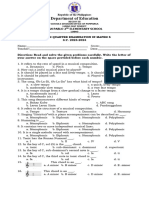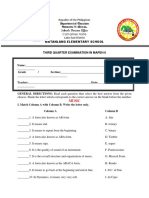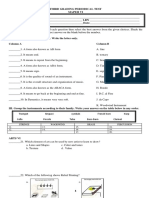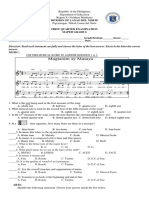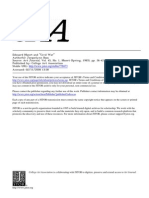PT Mapeh 6 Q3
PT Mapeh 6 Q3
Uploaded by
Maurin MaurinCopyright:
Available Formats
PT Mapeh 6 Q3
PT Mapeh 6 Q3
Uploaded by
Maurin MaurinOriginal Title
Copyright
Available Formats
Share this document
Did you find this document useful?
Is this content inappropriate?
Copyright:
Available Formats
PT Mapeh 6 Q3
PT Mapeh 6 Q3
Uploaded by
Maurin MaurinCopyright:
Available Formats
Republic of the Philippines
Department of Education
Region VII – Central Visayas
Division of Cebu Province
PINAMUNGAJAN DISTRICT 2
PUNOD ELEMENTARY SCHOOL
3RD PERIODICAL TEST IN MAPEH 6
Name : __________________________________________________________ Score:
_________________
Teacher: __________________________________________________________ Date:
__________________
General Instructions: Read each items carefully. Choose the letter of the correct answer.
MUSIC
1. ______________ is made up of two musical parts or has two different melodic ideas.
a. Unitary b. Binary c. Ternary d. Rondo
2. ______________ contains only one section which remains the same all throughout the whole composition.
a. Unitary b. Binary c. Ternary d. Rondo
3. ______________ is made up of five or more musical parts with some repetitions.
a. Unitary b. Binary c. Ternary d. Rondo
4. ______________ utilizes a three-part composition/form represented by (ABC) and sometimes, the third part is a
repetition of the first part represented by (ABA)
a. Unitary b. Binary c. Ternary d. Rondo
5. Which of the following songs has a ternary form?
a. Frere Jacques b. Amazing Grace c. Lupang Hinirang d. Maligaya Araw
6. ______________ are instruments that are plucked or bowed and are often referred to as the “backbone” of the
orchestra.
a. Stringed instruments c. Brass instruments
b. Woodwind instruments d. Percussions
7. The piccolo belongs to what classification of instrument?
a. Stringed instruments c. Brass instruments
b. Woodwind instruments d. Percussions
8. What is the name of the instrument shown on the image to the right.
a. double bass c. French horn
b. bass drum d. saxophone
9. What is the highest male voice range?
a. Alto b. Soprano c. Bass d. Tenor
10. What is the lowest female voice range?
a. Alto b. Soprano c. Bass d. Tenor
ART
11. What process of printmaking is shown on the image?
a. relief printing
b. intaglio printing
c. lithography
d. screen printing
12. __________________ is a printmaking process where the image holds ink.
a. relief printing b. intaglio printing c. lithography d. screen printing
13. What process of printmaking shown on the image?
a. relief printing
b. intaglio printing
c. lithography
d. screen printing
14. __________________ is a printmaking where ink passes through areas of a screen that are not blocked.
a. relief printing b. intaglio printing c. lithography d. screen printing
Arrange the process of silkscreen printing using the letters a to e.
________15. Position the printed film over the screen and expose it to a very bright light source.
________16. Prepare a design and print on transparency.
________17. Using a blow dryer, dry ink on the t-shirt. You know have a finished product.
________18. Prepare a mesh screen. Coat it with light-sensitive emulsion.
________19. Rinse of the excess emulsion. Once you have all the screens exposed and cleaned, you
are ready to print.
________20. Place screen over the t-shirt. Apply ink, any color of your choice, using a squeegee.
PHYSICAL EDUCATION
21. – 25. Perform the Fundamental Dance Positions (2 points each)
________21. First Position
________22. Second Position
________23. Third Position
________24. Fourth Position
________25. Fifth Position
26. – 30. Perform 5 basic Arm/Hand Positions as per selected by the teacher for you to perform.
(2 points each)
________ Amplified ________ “T” Position ________ Kewet/Kalawit
________ Lateral ________ Kumintang ________ Reversed “T”
________ Hayon-hayon ________ Sarok
HEALTH
Enumerate the Diseases and Disorders caused by Poor Environmental Sanitation
31. R__________________________________
32. G__________________________________
33. S__________________________________
34. N__________________________________
Put a check () for desirable human activities and a cross (x) for poor environmental sanitation practices.
__________35. Dumping garbage into rivers and ponds
__________36. Segregating wastes and garbage
__________37. Cyanide fishing
__________38. Recycling garbage
__________39. Walking and biking instead of riding motorcycles that emits gases
__________40. Tree-planting
May the odds be ever in your favor.
Good Luck!
You might also like
- Third Quarter Test MAPEHDocument5 pagesThird Quarter Test MAPEHJohnrey Tabano86% (22)
- Third Quarter Summative Test in MAPEHDocument4 pagesThird Quarter Summative Test in MAPEHMarilou Kimayong100% (20)
- Introduction To Children's LiteratureDocument17 pagesIntroduction To Children's LiteratureFrancis B. Tatel67% (3)
- MAPEH 6 3rd QUARTER TESTDocument6 pagesMAPEH 6 3rd QUARTER TESTDESIREE TAGLE100% (5)
- The Handy Book of Artistic Printing, Collection of Letterpress ExamplesDocument233 pagesThe Handy Book of Artistic Printing, Collection of Letterpress ExamplesLuka Fabjančič100% (6)
- Pettersson Rune ID4 Graphic Design PDFDocument285 pagesPettersson Rune ID4 Graphic Design PDFirenneNo ratings yet
- Q3 P.T. Mapeh 6Document7 pagesQ3 P.T. Mapeh 6Cristopher B. SumagueNo ratings yet
- BASELINE TEST MAPEH G6 Checked 1Document7 pagesBASELINE TEST MAPEH G6 Checked 1ANNIE ROSE PASTER100% (1)
- Mapeh 6 Periodic TestDocument5 pagesMapeh 6 Periodic Testmyrna parasNo ratings yet
- Mapeh 6 Quarterly ExamDocument5 pagesMapeh 6 Quarterly ExamRalph Fael LucasNo ratings yet
- Bongabong Elementary School Mapeh 6 ExamDocument4 pagesBongabong Elementary School Mapeh 6 ExamArthur MicarozNo ratings yet
- Mapeh 6Document6 pagesMapeh 6Khristine CalmaNo ratings yet
- Third Quarter Exam in Mapeh ViDocument9 pagesThird Quarter Exam in Mapeh ViMARLYN GAY EPAN100% (1)
- Mapeh 6 3RD PTDocument6 pagesMapeh 6 3RD PTJoanna Mirandilla DarayNo ratings yet
- Third Quarter Examination Mapeh 4Document3 pagesThird Quarter Examination Mapeh 4John Mark PentinioNo ratings yet
- Third Quarter Test MAPEHDocument5 pagesThird Quarter Test MAPEHelainerodriguez061517No ratings yet
- PT - Mapeh 6 - Q4 V1Document6 pagesPT - Mapeh 6 - Q4 V1JEROMENo ratings yet
- 3rd Quarter Week 5&6Document9 pages3rd Quarter Week 5&6keira ygotNo ratings yet
- PT - Mapeh 6 - Q4 V1Document6 pagesPT - Mapeh 6 - Q4 V1Ericka KayeNo ratings yet
- PT - Mapeh 6 - Q4 V2Document9 pagesPT - Mapeh 6 - Q4 V2Joy Carol MolinaNo ratings yet
- 3rd Quarter Test MAPEH 6Document4 pages3rd Quarter Test MAPEH 6mcm892010No ratings yet
- Mapeh 6 Third Periodical TestDocument2 pagesMapeh 6 Third Periodical TestMARY ROSE K. OMAMALIN100% (1)
- 4TH PT in Mapeh 6 23-24Document10 pages4TH PT in Mapeh 6 23-24Amiel GarciaNo ratings yet
- mapehFOURTH GRADING PT 2017-2018 FINAL WITH ANSWER KEYDocument5 pagesmapehFOURTH GRADING PT 2017-2018 FINAL WITH ANSWER KEYDiana B. Nichols100% (3)
- 2ND Mapeh 6Document3 pages2ND Mapeh 6Edmar MejiaNo ratings yet
- PT - Mapeh 6 - Q4 V1Document7 pagesPT - Mapeh 6 - Q4 V1Alyssa Panuelos FloresNo ratings yet
- Mapeh 6Document8 pagesMapeh 6Jodelyn Lleva RasqueroNo ratings yet
- Periodical Test in MAPEH 6Document7 pagesPeriodical Test in MAPEH 6catherine regisNo ratings yet
- EXAM - Grade 4Document21 pagesEXAM - Grade 4Melanie OrdanelNo ratings yet
- MAPEH 6 3rd Quater Exam 2017-2018Document6 pagesMAPEH 6 3rd Quater Exam 2017-2018Jason Albarico100% (4)
- Trumpet Timpani Cymbals French Horn Harp Cello Piccolo Tuba Bass Drum ClarinetDocument7 pagesTrumpet Timpani Cymbals French Horn Harp Cello Piccolo Tuba Bass Drum ClarinetJecTactay100% (2)
- Third Grading Periodical Test in Mapeh 6 2017-2018 DepedDocument6 pagesThird Grading Periodical Test in Mapeh 6 2017-2018 DepedJohnrey Tabano85% (13)
- Fourth Quarter Grade 3Document4 pagesFourth Quarter Grade 3edsuminjr.pgeNo ratings yet
- First Summative Test in MapehDocument2 pagesFirst Summative Test in MapehVANESSA KEITH CARONNo ratings yet
- 3rd Quarter PTDocument6 pages3rd Quarter PTJohn Paul CapistranoNo ratings yet
- Worksheets 5Document4 pagesWorksheets 5LEILA SILVESTRENo ratings yet
- Mapeh 7 - 1ST QUARTERDocument5 pagesMapeh 7 - 1ST QUARTERCherryn Dorotayo QuiminsaoNo ratings yet
- MAPEH Grade 6 1Document5 pagesMAPEH Grade 6 1Janelle Grace Espra YongcoNo ratings yet
- Diagnostic Test in Mapeh With Key & TosDocument5 pagesDiagnostic Test in Mapeh With Key & TosLYNN MADDAWATNo ratings yet
- About Off On Apart of Out With Behind in Over Up Down For Through ToDocument3 pagesAbout Off On Apart of Out With Behind in Over Up Down For Through ToJENNY JANE ZAMORANo ratings yet
- Summative TestDocument3 pagesSummative TestJENNY JANE ZAMORANo ratings yet
- Pre-Test - Mapeh 6Document5 pagesPre-Test - Mapeh 6Raffy TabanNo ratings yet
- Mapeh 10Document3 pagesMapeh 10JollyGay Tautoan LadoresNo ratings yet
- FOURTH PERIODIC TEST IN MAPEH 2022 2023 - TrueDocument2 pagesFOURTH PERIODIC TEST IN MAPEH 2022 2023 - TrueGilvert A. PanganibanNo ratings yet
- 3rd Summative TestDocument10 pages3rd Summative TestEM GinaNo ratings yet
- PT - Mapeh 6 - Q4 V2Document7 pagesPT - Mapeh 6 - Q4 V2JEROMENo ratings yet
- MAPEH 6 - 4th PT - FinalDocument4 pagesMAPEH 6 - 4th PT - FinalRolly Manuel JrNo ratings yet
- Fourth Periodic Test in Mapeh 6: Department of EducationDocument7 pagesFourth Periodic Test in Mapeh 6: Department of EducationMarlynSanchezTenorioNo ratings yet
- Fourth Periodic Test in Mapeh 6: Marka/IskorDocument8 pagesFourth Periodic Test in Mapeh 6: Marka/IskorChristine KigisNo ratings yet
- 4th MapehDocument8 pages4th MapehJERALD MONJUANNo ratings yet
- Pre Test - Mapeh 6Document5 pagesPre Test - Mapeh 6Bencea CoronadoNo ratings yet
- Third Grading Periodical Test in Mapeh 6 2017-2018Document6 pagesThird Grading Periodical Test in Mapeh 6 2017-2018Jerome MapacpacNo ratings yet
- PT - MAPEH 6 - Q4 TosDocument6 pagesPT - MAPEH 6 - Q4 TosArnel Lampara ManabatNo ratings yet
- PT - Mapeh 6 - Q4 V2Document7 pagesPT - Mapeh 6 - Q4 V2Roscel Joy M. JarantillaNo ratings yet
- Pre-Test Mapeh 6Document5 pagesPre-Test Mapeh 6RANDY ALVARONo ratings yet
- PT - Mapeh 6 - Q4 V2Document7 pagesPT - Mapeh 6 - Q4 V2Ann LlagasNo ratings yet
- 3rd SUMMATIVE MAPEH 6Document5 pages3rd SUMMATIVE MAPEH 6Baby Lanny CardeñoNo ratings yet
- Third Grading Periodical Test in Mapeh 6 2017-2018 DepedDocument6 pagesThird Grading Periodical Test in Mapeh 6 2017-2018 DepedClint AbantoNo ratings yet
- PT - Mapeh 6 - Q4 V2Document10 pagesPT - Mapeh 6 - Q4 V2Cherry Mae CaranzaNo ratings yet
- Learn English 2 With Audio and Video.: Learn English, #2From EverandLearn English 2 With Audio and Video.: Learn English, #2Rating: 2.5 out of 5 stars2.5/5 (3)
- Humanities - 2Document350 pagesHumanities - 2PrinceCataylo100% (2)
- Module 9 10 CparDocument43 pagesModule 9 10 CparPaul Zacchaeus MapanaoNo ratings yet
- 版画:作为艺术作品的版本Document7 pages版画:作为艺术作品的版本杨山好No ratings yet
- Kitchen Lithography As An Alternative To Traditional LithographyDocument13 pagesKitchen Lithography As An Alternative To Traditional LithographyHarry SyahrizalNo ratings yet
- UNIT 9-12 PrintingDocument19 pagesUNIT 9-12 Printing22158109No ratings yet
- Edouard Manet and Civil War PDFDocument8 pagesEdouard Manet and Civil War PDFMavi ErtunaNo ratings yet
- UV Offset LAB Report Final 7-06Document24 pagesUV Offset LAB Report Final 7-06Rustom KangaNo ratings yet
- Lesson 1 Print Production History of PrintingDocument42 pagesLesson 1 Print Production History of PrintingneildomNo ratings yet
- Arts Appreciation WEEK 5Document5 pagesArts Appreciation WEEK 5Andrea Nicole De LeonNo ratings yet
- Forensic 4 FinalsDocument21 pagesForensic 4 Finalsmirameee131No ratings yet
- Chile Hackmey Broschure CompleteDocument20 pagesChile Hackmey Broschure CompleteAdrián SaavedraNo ratings yet
- Drawing, Painting, and 2-D ArtDocument58 pagesDrawing, Painting, and 2-D ArtSk.Abdul NaveedNo ratings yet
- Techkon Expanded Gamut Whitepaper FinalDocument37 pagesTechkon Expanded Gamut Whitepaper Final가입용No ratings yet
- Art Appreciation Notes UNIT - 1Document13 pagesArt Appreciation Notes UNIT - 1francy sharonNo ratings yet
- Victorian Graphic DesignDocument3 pagesVictorian Graphic DesignteachitrealNo ratings yet
- 078 VintagePosters PDFDocument67 pages078 VintagePosters PDFDavid Ellis100% (5)
- An Introduction To The Tin CanDocument10 pagesAn Introduction To The Tin CandrewmbaileyNo ratings yet
- Minimising Voc Emissions From Victoria'S Printing IndustryDocument9 pagesMinimising Voc Emissions From Victoria'S Printing IndustryHafiani HichamNo ratings yet
- 2nd Long Test Mapeh 7Document2 pages2nd Long Test Mapeh 7An Tho NeeNo ratings yet
- Digital Publication PowerpointDocument12 pagesDigital Publication Powerpointapi-307992879No ratings yet
- Technical Information: UN IT IamondDocument2 pagesTechnical Information: UN IT IamondTanjaNo ratings yet
- Fine Prints & Photography - Skinner Auction 2560BDocument148 pagesFine Prints & Photography - Skinner Auction 2560BSkinnerAuctions100% (2)
- Hand Printing: Chloe JacksDocument13 pagesHand Printing: Chloe JackschloejacksNo ratings yet
- Salvador Dali Les Amoureus StoryDocument10 pagesSalvador Dali Les Amoureus StoryTon RiveraNo ratings yet
- The Technical Aspects of Degas's ArtDocument26 pagesThe Technical Aspects of Degas's ArtFrank Hobbs100% (1)
- I R D S: Nternational Oadmap FOR Evices and YstemsDocument11 pagesI R D S: Nternational Oadmap FOR Evices and YstemsPragya KushwahaNo ratings yet
- Survey and ResearchDocument12 pagesSurvey and ResearchNajwa WawaNo ratings yet






















